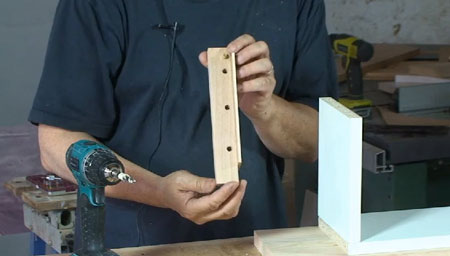Today there are many ways to assemble two pieces of wood.
Traditional wood working joints like mortise and tenon and dovetails are still often an excellent option for solid wood, but modern day options like biscuits, dominos, and dowels are often much faster to make and more adapted to modern sheet materials.
As I build mainly stairs my joints are typically structural joining of strings and handrails either string to string or string to posts. But as projects often include under stair cupboards, and we also make the occasional kitchens, closets and so on, we are often been involved with cabinetry.
In stair building I quickly found that traditional mortise and tenon were not really adapted to modern stair building, and we replaced them with a bolted joint using dowels to maintain the precise relative positions of the parts.
To position the dowels and drill the hole for blots I built a simple dowelling jig that enabled us to produce a fast, strong and precise joint. I’ve set up a series of videos explaining how to build and use this bolt and dowel assembly jig.

When joining parts for cabinetry I quickly found that with a little adaptation we could use the same jig principle, without the bolt, to produce a quick and efficient dowel joint for boards and also to replace mortise and tenon in small framed panels.
Dowels make a surprisingly strong joint and if you use a jig, are very easy and cheap to make.
You can buy various commercial dowel jigs at various prices but it’s quick and easy to build a homemade doweling jig on the fly that, adapted to a specific job, will make your joints fast, easy and for free.
If you have a biscuit jointer you’ll find that although fine for joining boards edge to edge marking out the biscuit positions can be tedious. Using a homemade dowelling jig will make a faster joint. As well as this biscuits will protrude out of the edge when joining parts that are less than 70mm wide, whereas a DIY dowel jig can be adapted to any width or length.
Dominos make a great joint without the problems of biscuits but you should be making cabinets regularly to pay for the rather hefty price tag on the machine.
If you are an amateur or make cabinets occasionally try making a dowel jig yourself. It’ll cost nothing and you will be able to adapt the principle to a variety of jobs from boards, to frames, though edge to edge joining, end to end joints, cam placement jigs, drilling into walls, and so on.
This next video shows you the detail of how to build this jig.
And this video shows you how to use it.
For more workshop tips and expert advice, please sign up here to Wood Designer.
You can also download and use our professional stair software and Polyboard furniture software.
Thanks very much!

[…] Check the tutorial […]